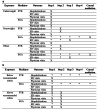Maternal weight and paediatric health use: mediating role of adverse birth outcomes: a retrospective cohort study
- PMID: 37525105
- PMCID: PMC10388559
- DOI: 10.1186/s12884-023-05744-w
Maternal weight and paediatric health use: mediating role of adverse birth outcomes: a retrospective cohort study
Abstract
Background: Maternal pre-pregnancy body mass index (BMI) and gestational weight gain (GWG) above or below recommendations have been associated with increased paediatric health service utilization as well as increased risk of adverse birth outcomes, including small for gestational age (SGA) and preterm birth (PTB). SGA and PTB are associated with numerous adverse health outcomes in the child, including delayed growth, motor and cognitive impairment. Previous research has identified birth weight and gestational age on the causal pathway in the association between maternal pre-pregnancy BMI and child hospital admissions, there are no studies to date to quantify this relationship across other areas of health service utilization, nor the impact of gestational weight gain. This study aimed to assess if SGA or PTB partially explain the association between maternal weight and paediatric health service utilization.
Methods: The study population consisted of all women who delivered a singleton, live infant in Ontario between 2012 and 2014, and was assembled from data contained in the provincial birth registry. Health service utilization over the first 24 months following birth was examined by linking data from the registry with other provincial health administrative databases housed at ICES. The mediating roles of PTB and SGA were assessed using the Baron-Kenny method and causal mediation analysis.
Results: A total of 204,162 infants were included in the analysis of maternal pre-pregnancy BMI and 171,127 infants were included in the GWG analysis. The small magnitude of association between maternal BMI and paediatric health service utilization impacted our ability to estimate the indirect effect of maternal BMI through adverse birth outcomes (adjusted indirect effect = 0.00). 56.7% of the association between below recommended GWG and increased hospitalizations was attributed to PTB, while 6.8% of the association was attributed to SGA.
Conclusion: Paediatric hospitalizations may be partially attributable to PTB and SGA in children born to mothers with below-recommended GWG. However, maternal weight also appears to be related to increased paediatric health service utilization independent of PTB and SGA.
Keywords: Health Services; Obesity; Pediatrics; Perinatal epidemiology; Pregnancy.
© 2023. The Author(s).
Conflict of interest statement
The authors declare no competing interests.
Figures



Similar articles
-
Metformin for women who are overweight or obese during pregnancy for improving maternal and infant outcomes.Cochrane Database Syst Rev. 2018 Jul 24;7(7):CD010564. doi: 10.1002/14651858.CD010564.pub2. Cochrane Database Syst Rev. 2018. PMID: 30039871 Free PMC article.
-
Gestational weight gain below instead of within the guidelines per class of maternal obesity: a systematic review and meta-analysis of obstetrical and neonatal outcomes.Am J Obstet Gynecol MFM. 2022 Sep;4(5):100682. doi: 10.1016/j.ajogmf.2022.100682. Epub 2022 Jun 18. Am J Obstet Gynecol MFM. 2022. PMID: 35728780
-
Multiple-micronutrient supplementation for women during pregnancy.Cochrane Database Syst Rev. 2017 Apr 13;4(4):CD004905. doi: 10.1002/14651858.CD004905.pub5. Cochrane Database Syst Rev. 2017. Update in: Cochrane Database Syst Rev. 2019 Mar 14;3:CD004905. doi: 10.1002/14651858.CD004905.pub6. PMID: 28407219 Free PMC article. Updated.
-
Gestational weight gain across continents and ethnicity: systematic review and meta-analysis of maternal and infant outcomes in more than one million women.BMC Med. 2018 Aug 31;16(1):153. doi: 10.1186/s12916-018-1128-1. BMC Med. 2018. PMID: 30165842 Free PMC article.
-
Different corticosteroids and regimens for accelerating fetal lung maturation for babies at risk of preterm birth.Cochrane Database Syst Rev. 2022 Aug 9;8(8):CD006764. doi: 10.1002/14651858.CD006764.pub4. Cochrane Database Syst Rev. 2022. PMID: 35943347 Free PMC article.
References
-
- Cameron CM, Shibl R, Mcclure RJ, Ng S, Hills AP. Maternal pregravid body mass index and child hospital admissions in the fi rst 5 years of life: results from an Australian birth cohort. 2014;(April):1268–74. - PubMed
-
- Neggers Y, Goldenberg RL, Ramey SL, Cliver, Suzane P. Maternal prepregnancy body mass index and psychomotor development in children. Acta Obs Gynecol Scand. 2003;82(6). - PubMed
-
- Juneja M, Shankar A, Ramji S. Neurodevelopmental, functional and growth status of term low birth weight infants at eighteen months. Indian Pediatr. 2005;I:1134–40. - PubMed
MeSH terms
Grants and funding
LinkOut - more resources
Full Text Sources
Medical

